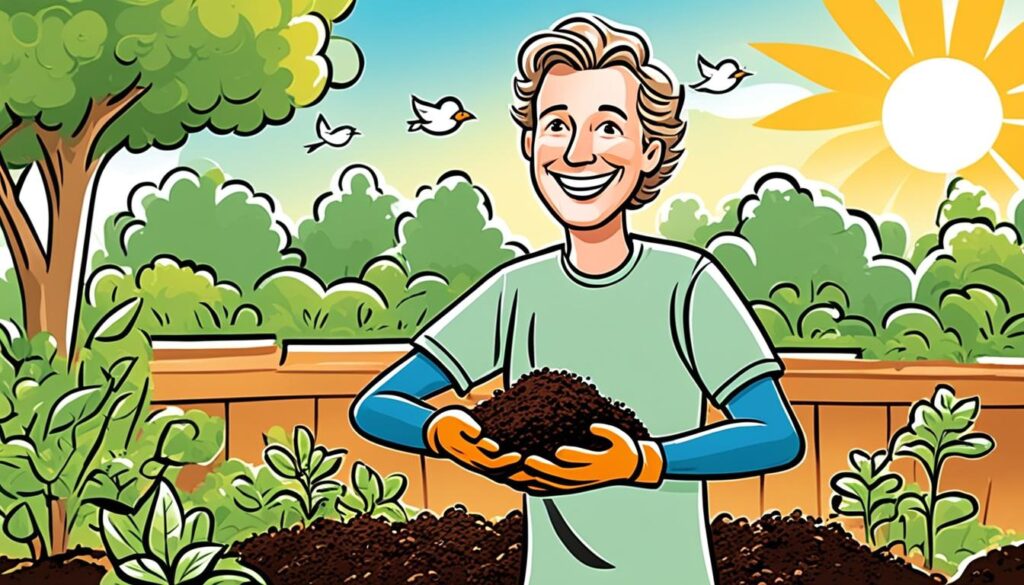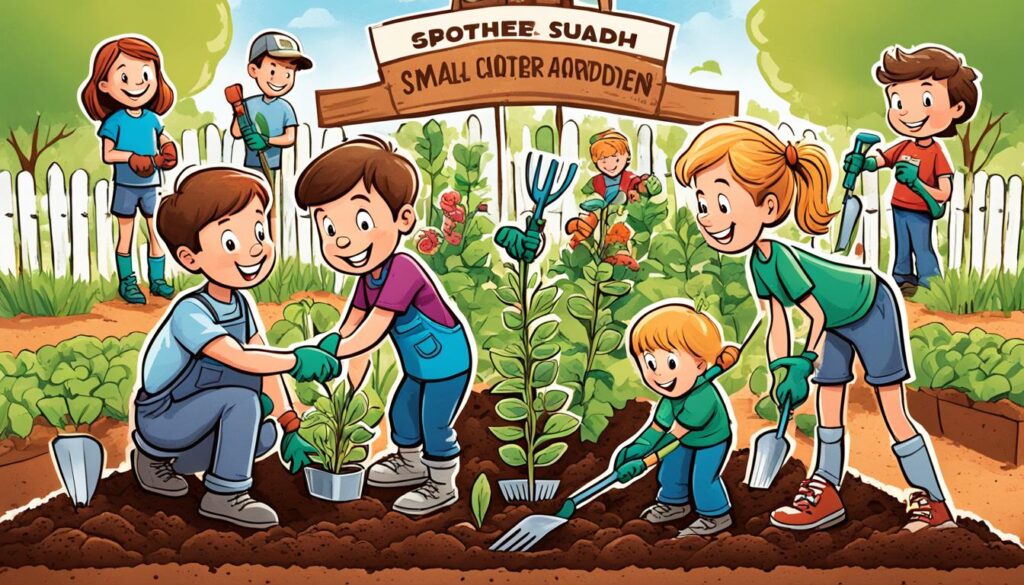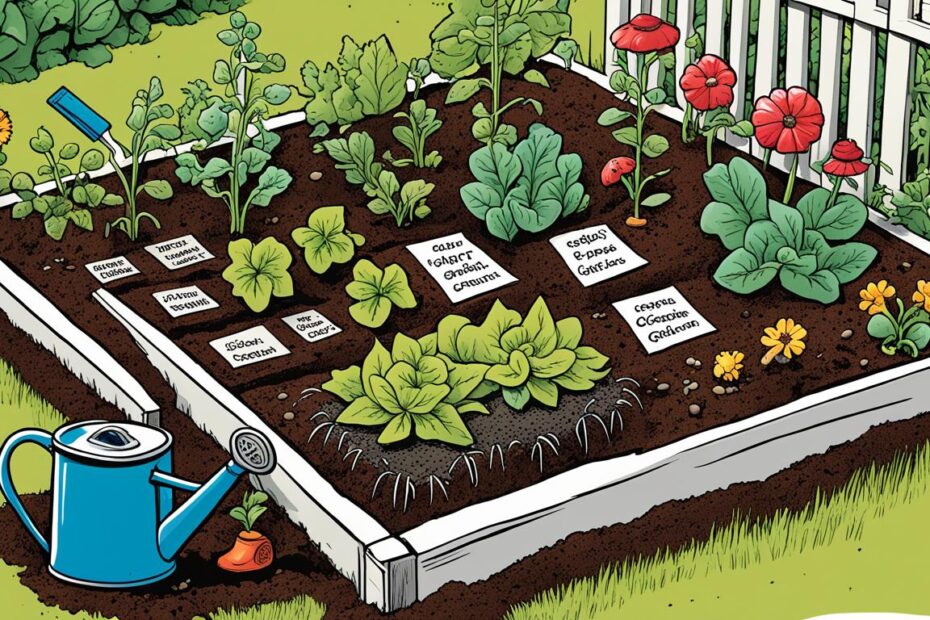Are you ready to transform your gardening experience? Imagine a lush, abundant garden filled with healthy, vibrant plants, all in a limited space. With square foot gardening, your vision can become a reality. But here’s the question: what makes square foot gardening so unique and effective? Is it the soil? The gardening methods? Or the innovative Back to Eden approach?
In this article, we will delve into the world of square foot gardening and unravel the secrets to creating optimal garden soil. We’ll explore the benefits of this popular gardening method and how it can revolutionize the way you grow your plants. From constructing the perfect raised beds to using wood chips as a soil cover, we’ll cover it all.
Key Takeaways:
- Square foot gardening allows for more plants to be grown in a limited space.
- The Back to Eden method involves using a cover of wood chips or organic material to improve soil quality.
- Square foot gardening offers easy maintenance, companion planting, and larger harvests with minimal effort.
- The basics of square foot gardening include a 4×4-foot frame and intensive rotational planting.
- Gardening with kids in a square foot garden can instill valuable life skills and a sense of accomplishment.
The Benefits of Square Foot Gardening
Square foot gardening offers several benefits compared to traditional gardening methods. The ease and simplicity of this approach make gardening a breeze, even for beginners. Here are some key advantages of square foot gardening:
- Easy Gardening: Square foot gardening is a low-maintenance technique that reduces the need for heavy digging and weeding. The compact nature of square foot gardens makes it easier to manage and maintain compared to traditional row gardening.
- Companion Planting: In square foot gardening, companion planting is highly encouraged. This practice involves growing compatible plants together, which helps deter pests, improve pollination, and enhance nutrient uptake. Companion planting promotes a healthier and more sustainable garden ecosystem.
- Larger Harvest: Despite its smaller size, a well-designed square foot garden can yield a surprisingly bountiful harvest. By utilizing every square foot efficiently and avoiding overcrowding, you can maximize your vegetable production.
- Minimal Effort: Square foot gardening is designed to be efficient and requires minimal effort. The close proximity of plants limits weed growth, and the use of raised beds minimizes soil erosion. With proper planning and organization, maintaining a square foot garden can be a breeze.
- Healthier Vegetables: By providing each plant with ample space, square foot gardening promotes better air circulation and reduces the risk of disease transmission. Additionally, the controlled environment allows for more precise watering and nutrient management, resulting in healthier and more flavorful vegetables.
“Square foot gardening offers easy maintenance, larger harvests, and healthier vegetables.”
With its convenient layout and efficient use of space, square foot gardening is a practical and rewarding gardening method. Whether you’re a seasoned gardener or a beginner, you can enjoy the benefits of square foot gardening while enjoying a flourishing vegetable garden.

The Basics of Square Foot Gardening
Square foot gardening, originally promoted by Mel Bartholomew in the 1980s, is a popular gardening method that allows you to maximize your growing space. It involves creating a small frame, typically 4×4 feet in size, divided into square foot sections. Each section is then planted with a specific number of vegetables, following an intensive rotational planting method.
The construction materials for the frame can vary, depending on your preferences and budget. Common options include untreated lumber, composite boards, or even recycled materials. The frame should be sturdy and durable to support the weight of the soil and plants.
The depth of the frame is an important consideration, as it determines the suitability for different types of crops. While shallow frames are sufficient for above-ground vegetables like lettuce and herbs, root vegetables like carrots and potatoes require a deeper frame. Aim for a depth of at least 6-12 inches to accommodate most crops.
Looking to get started with square foot gardening? Follow these steps:
- Prepare your frame: Construct a 4×4-foot frame using suitable construction materials.
- Divide the frame: Create square foot sections within the frame using durable dividers like wooden slats or strings.
- Prepare the soil: Fill each section with a high-quality, well-draining soil mix enriched with compost and other organic matter.
- Choose your plants: Select the appropriate vegetables for each square foot section based on their spacing and compatibility.
- Plant and maintain: Plant your seeds or seedlings according to the recommended planting distances. Follow proper watering, fertilizing, and pest control practices.
Benefits of Square Foot Gardening
Square foot gardening offers several advantages over traditional gardening methods. Here are the key benefits:
- Maximized space utilization: By planting in square foot sections, you can grow a larger variety of crops in a smaller area.
- Easy weed and pest control: The well-defined sections make it easier to identify and control weeds and pests, allowing for a healthier garden.
- Efficient watering: With designated sections, you can water each plant precisely, reducing water wastage and saving time.
- Intensive planting: The rotational planting method ensures that you make the most of your growing space by continuously replacing harvested crops with new ones.
- Accessibility: The compact nature of square foot gardens makes it easier to reach and tend to your plants, reducing strain and providing an enjoyable gardening experience.
“Square foot gardening is a fantastic way to grow your own fruits and vegetables. By dividing your garden into small, manageable sections, you can effectively utilize space, conserve resources, and enjoy the bounty of a thriving garden.” – Mel Bartholomew
| Crop Type | Suitable Depth |
|---|---|
| Above-Ground Vegetables (Lettuce, Herbs) | 6-8 inches |
| Root Vegetables (Carrots, Potatoes) | 12 inches or more |
| Vining Crops (Tomatoes, Cucumbers) | 8-12 inches |
Square Foot Gardening with Kids
Gardening is not just for adults, it’s an excellent activity that can provide kids with valuable life skills and hands-on learning opportunities. Square foot gardening, in particular, is a wonderful way to engage children in the world of gardening and nature. With a kid-sized Square Foot Garden, measuring 3×3 feet, little ones can easily manage their own green space and cultivate their love for plants.
Getting kids involved in the construction process of their square foot garden is a great way to teach them about the importance of teamwork and responsibility. The construction materials are simple, and with a little guidance, they can help build their own garden bed.
“Gardening is a labor of love that teaches kids the value of patience, perseverance, and hard work.”
When it comes to choosing plants for the kid-sized Square Foot Garden, there are plenty of small vegetable varieties that are perfect for little gardeners. They can try their hands at growing pumpkins, lettuce, carrots, tomatoes, radishes, beans, and even flowers to add a splash of color to their garden.
Gardening with kids not only allows them to develop a sense of self-sufficiency and accomplishment but also fosters a greater appreciation for the environment. It teaches them about the importance of nurturing and caring for living things, and the joy of watching their garden thrive.

Benefits of Square Foot Gardening for Kids:
- Develops life skills such as responsibility and patience.
- Encourages a sense of accomplishment and self-confidence.
- Teaches kids about the environment and the importance of preserving it.
- Fosters a love for nature and plants.
- Provides a hands-on learning experience about how food grows.
- Promotes healthy eating habits by growing their own vegetables.
By introducing kids to square foot gardening, you are not only nurturing their curiosity and love for nature but also equipping them with valuable life skills that will stay with them for years to come.
| Vegetable Varieties | Level of Difficulty | Growing Season |
|---|---|---|
| Pumpkins | Easy | Spring to Fall |
| Lettuce | Easy | Spring to Fall |
| Carrots | Easy | Early Spring to Fall |
| Tomatoes | Moderate | Spring to Fall |
| Radishes | Easy | Spring to Fall |
| Beans | Easy | Spring to Fall |
| Flowers | Easy | Spring to Fall |
Choosing the Right Soil for Your Square Foot Garden
When it comes to square foot gardening, the soil you choose plays a vital role in the success of your plants. It sets the foundation for healthy growth and abundant harvests. So, how do you select the perfect soil for your square foot garden?
The first consideration is the soil composition. Your soil should have a well-balanced mixture of different components. It should contain a good amount of organic matter that provides essential nutrients to your plants. Incorporating compost into your soil is an excellent way to boost its organic matter content.
Next, it’s crucial to assess the nutrient content of your soil. Different plants have varying nutrient requirements, and it’s essential to provide them with the right balance. Conducting a soil test will help you determine the current nutrient levels and identify any deficiencies or imbalances. Armed with this information, you can then make the necessary amendments to optimize nutrient availability.
Another critical factor to consider is drainage. Excess water can be detrimental to plant roots, causing root rot and other issues. A well-draining soil allows water to freely pass through while still retaining enough moisture for the plants. Ensuring proper drainage will help prevent waterlogging and promote healthy plant growth.
The pH balance of your soil is also important. Different plants thrive in different pH levels. Conducting a pH test will help you determine the acidity or alkalinity of your soil. Most vegetables prefer a slightly acidic to neutral pH range of 6.0 to 7.0. If your soil’s pH falls outside this range, you can make adjustments by adding specific amendments.
Compost, vermiculite, and peat moss are excellent amendments to improve your soil composition and provide necessary nutrients. Compost enriches the soil with organic matter and beneficial microorganisms. Vermiculite helps with moisture retention and provides aeration to the soil. Peat moss enhances water retention capabilities and improves soil structure.
Remember, a healthy square foot garden starts with the right soil. By ensuring a well-balanced soil composition, maintaining proper nutrient levels, optimizing drainage, and adjusting the pH as needed, you’ll create an ideal environment for your plants to thrive and flourish.
Soil Amendments for Square Foot Gardening
| Amendment | Function |
|---|---|
| Compost | Enriches soil with organic matter and beneficial microorganisms |
| Vermiculite | Improves moisture retention and provides aeration to the soil |
| Peat Moss | Enhances water retention capabilities and improves soil structure |
Conclusion
Create your own lush and vibrant gardens with square foot gardening and experience the many benefits it offers. By combining this method with techniques like Back to Eden, you can optimize your gardening efforts in limited spaces. The result? Bountiful harvests and beautiful greenery right at your fingertips.
One of the key advantages of square foot gardening is its ability to produce larger harvests. By maximizing the use of space and following the optimal gardening methods, you can grow an abundance of vegetables and herbs in a small area. The intensive planting and companion planting techniques allow for efficient use of resources and minimal effort, resulting in healthier and tastier produce.
Don’t forget to involve the next generation in gardening adventures! Square foot gardening is an excellent way to introduce kids to the joys of growing their own food and nurturing nature. By creating a kid-sized square foot garden, children can learn valuable life skills, develop a sense of responsibility, and experience the satisfaction of watching their efforts bloom.
To ensure the success of your square foot garden, choose the right soil composition. Organic matter, proper drainage, and nutrient balance are essential for the optimal growth of your plants. Conducting a soil test and incorporating amendments such as compost, vermiculite, and peat moss can further enhance the quality of your square foot garden soil.
Inspired by the possibilities of square foot gardening? Start your gardening journey today and enjoy the rewards of a thriving and beautiful garden. With optimal gardening methods and the joy of gardening with kids, you’ll create your own little Eden right at home.
FAQ
What is square foot gardening?
Square foot gardening is a gardening method that involves planting in squares instead of rows, allowing for more plants to be grown in a limited space.
What is the Back to Eden method?
The Back to Eden method involves using a cover of wood chips or other organic material to improve soil quality and reduce the need for watering and weeding in the garden.
How does square foot gardening benefit compared to traditional gardening?
Square foot gardening offers benefits such as easier maintenance, healthier plants, and the ability to incorporate companion planting, reducing the need for chemical fertilizers and pest control methods.
Who promoted square foot gardening?
Square foot gardening was originally promoted by Mel Bartholomew in the 1980s.
How do you construct a square foot garden?
A square foot garden is typically constructed using a small frame, measuring 4×4 feet in size, divided into square foot sections. The construction materials for the frame can vary, and the depth of the frame depends on the types of crops being grown.
How can square foot gardening be done with kids?
Square foot gardening with kids can be done by creating a kid-sized Square Foot Garden, involving them in the construction process, and choosing small vegetable varieties suitable for kids to grow.
How do you choose the right soil for a square foot garden?
To choose the right soil for your square foot garden, it should have a good balance of organic matter and nutrients, proper drainage to prevent waterlogging, and conducting a soil test to determine the pH balance and nutrient levels. Amendments like compost, vermiculite, and peat moss can be added to improve the soil composition and provide essential nutrients.
